Affiliate disclosure: This post may contain affiliate links. Please see our Privacy Policy.
Dandelion wine captures the essence of summer. Sweet, floral and with subtle notes of honey, dandelion wine is tasty enough to bring out the forager in anyone. It takes quite a few dandelions to make wine, so it’s best to enlist the help of as many small children as possible.
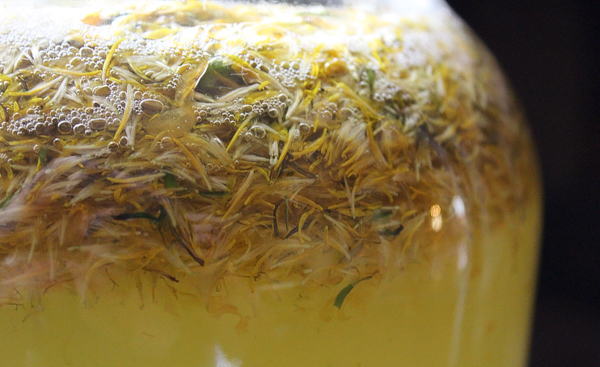
The author of Backyard Medicine talks about how her very first job as a child was collecting dandelions for her neighbor’s dandelion wine. He paid her by the paper sack full and she was happy to do it.
The first time we made dandelion mead, a type of dandelion honey wine, I enlisted the help of a 4-year-old neighbor girl. She picked enough dandelions for a 5-gallon batch in about an hour.
After that, every time I saw her for the rest of the summer she would bring me dandelions. That little neighbor girl is a teenager now, and I have my own daughter to lend a hand.
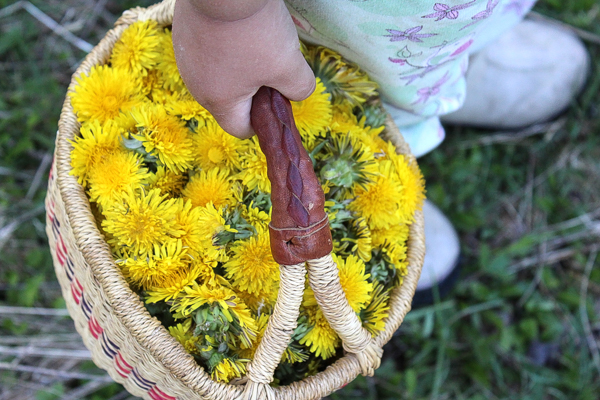
The real work in making dandelion wine is not collecting the dandelions. It’s in splitting apart the dandelions and removing the green leaves from each blossom. The green leaves have a milky sap that will ruin the taste of dandelion wine, and a good batch only uses the petals.
This year, my 3-year-old daughter picked about a gallon of blossoms in about 15 minutes, but we spent over an hour picking the petals from the flower heads.
It’s pleasant work for a warm afternoon, and I had my best girl sitting across from me. I successfully bribed her for the task by promising that some of the blossoms would be used to make dandelion ice cream.
(Since then I’ve bribed the littles with dandelion cookies, dandelion marshmallows, and even dandelion gummy bears…there’s a reason I have so many dandelion recipes in my back pocket…and that reason is wine!)
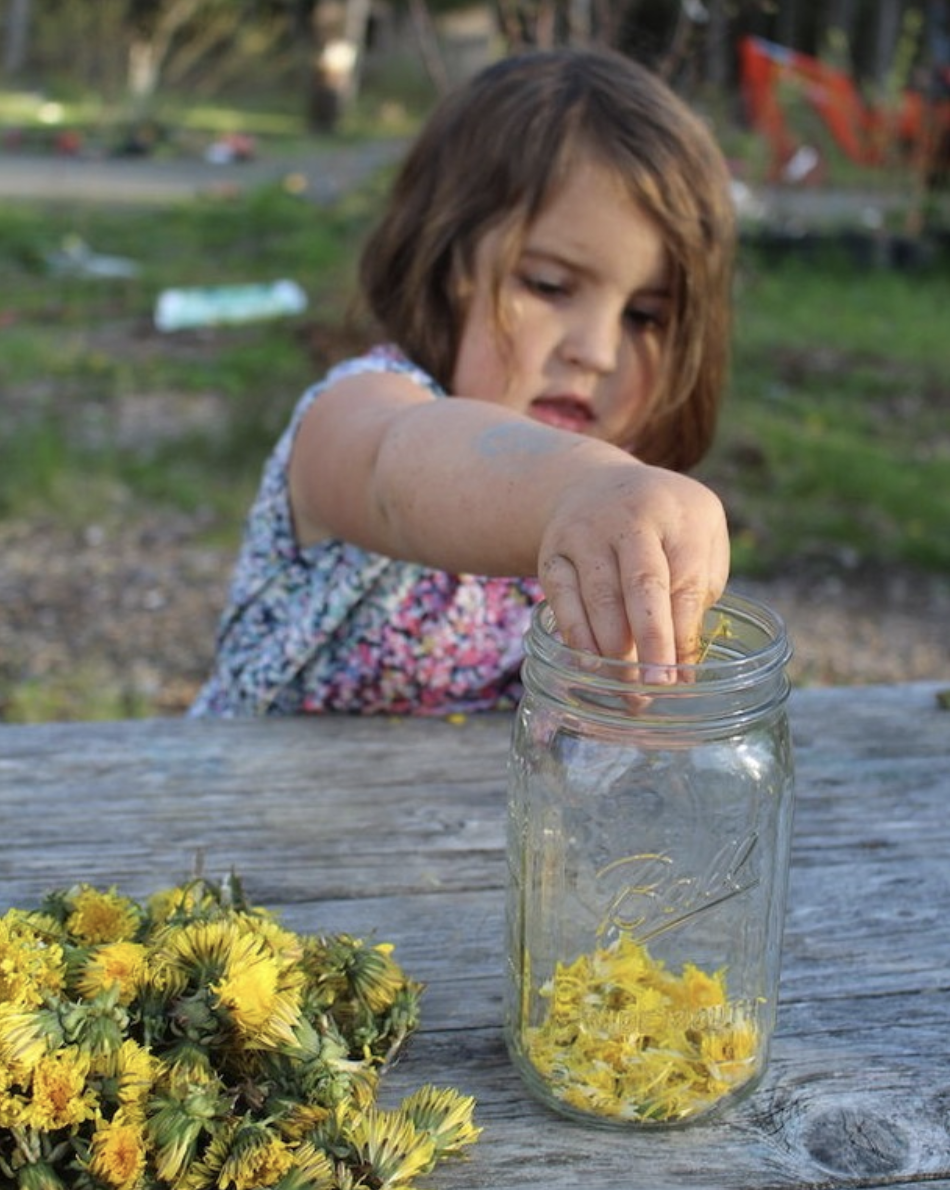
Given that it’s a bit labor-intensive to clean dandelion flowers for wine, plan on making a small batch.
You can make a 5-gallon batch in a traditional carboy, but unless you’ve got a lot of devoted friends, your fingers will likely give out before you have enough dandelion petals.
I had originally planned to make a super tiny 1-quart batch in a quart mason jar. It’s easy enough to attach a mason jar fermentation kit and brew on a very tiny scale.
In the end, we made better progress than I’d anticipated and ended up with enough petals for a full one-gallon batch of dandelion wine.
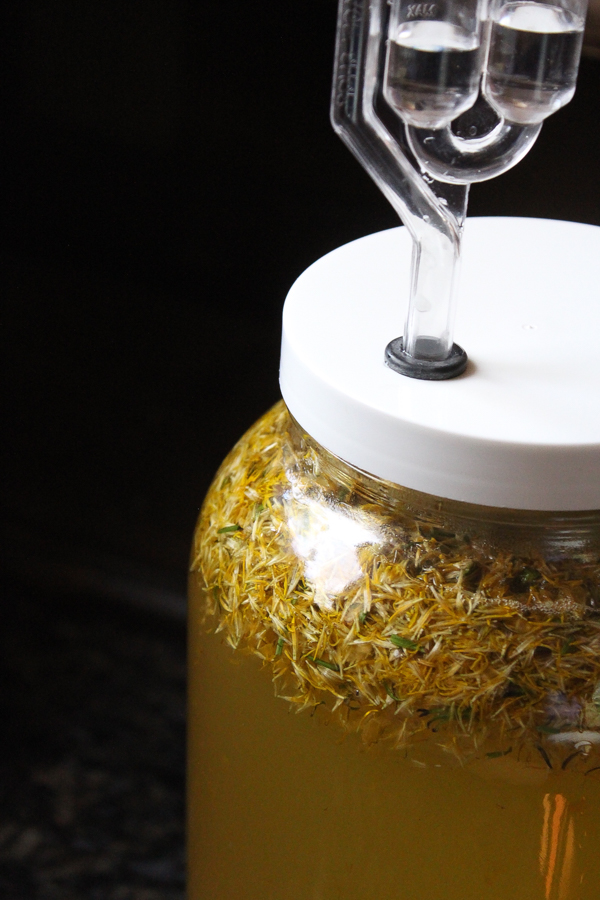
That means I get to try out my new wide mouth one-gallon carboy. If you’ve ever tried to clean out a narrow neck carboy after you’ve brewed with flower petals or any other small particulate, you’ll understand why the wide mouth is so convenient.
Dandelion petals will glue themselves to the inside of the neck of your fermentation vessel and you’ll be scrubbing with a bottle brush for a while unless you use something big enough to get a hand into.
After the primary ferment, the dandelion petals need to be filtered out as the wine is racked into a clean secondary fermentation vessel.
The wide mouth on this fermenter makes that an easy job, and you can just scoop the floating flower petals off the surface before racking.
Racking is a winemaking term, but it just means transferring the wine to a new clean container while leaving the sediment at the bottom behind. This is often done with a siphon for the best results, but it can be done by just pouring the wine carefully into a new container.
It helps to have 2 fermentation vessels, so there’s a clean one waiting, but lacking that, pouring the dandelion wine into a pair of half-gallon mason jars temporarily while you wash out the fermenter works too.
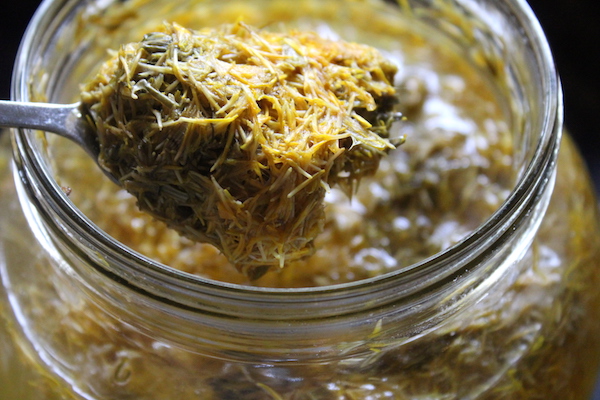
This dandelion wine is made using a cold infusion, which means that the sugar syrup goes in cold, and more of the floral flavor of the dandelions is preserved in the final wine.
You can just make a dandelion tea and filter out the petals before brewing, but the hot water used to make the tea will drive off some of the volatile flavors of the dandelions, and the resulting wine will taste a bit different.
Still, making a tea is much cleaner than brewing with flower petals in the fermenter, and you won’t run the risk of the flower petals bubbling up into the airlock and clogging up the works. If that does happen, just take off the airlock and clean things out before putting it all back together.
If you’re lacking a siphon or other brewing equipment, you can simply brew up this dandelion wine in a pair of half-gallon mason jars equipped with inexpensive silicone water locks. Once the primary ferment is over, scoop off the dandelion petals and carefully pour the wine through a fine mesh strainer into the secondary, leaving the sediment behind.
Reattach a water lock and you’re good to go until bottling time.
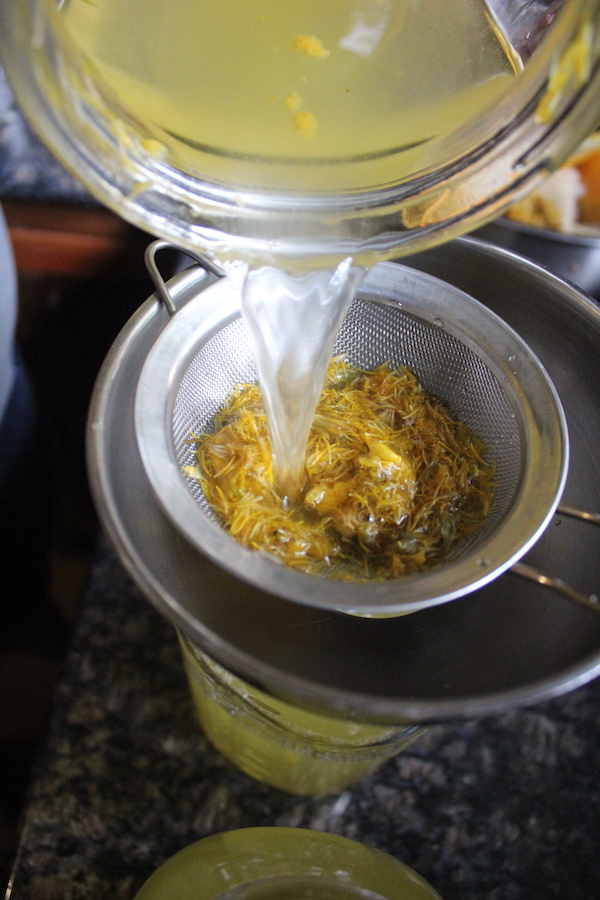
The final wine has a cleaner flavor if you don’t add raisins to the batch, but the yeast work more efficiently with either a few raisins in the wine to provide micro-nutrients that are missing from plain table sugar.
You can also add 1 teaspoon of yeast nutrient to the dandelion wine which will provide nutrients for the yeast without changing the flavor of the finished wine.
That’s really the best solution for the best dandelion wine quality.
How Does Dandelion Wine Taste?
If you’ve done it right, a propper dandelion wine tastes sweet, mild, and floral. You can almost feel the sunshine splash against your tongue, and it goes down smooth with no hints of bitterness.
We tried this batch in January, after about 6 months in the bottle and it was just right. More importantly, it was just what I needed on a cold Vermont evening, with more snow in the forecast and several feet already down on the ground.
Spring will come again, and sipping this little beauty brings me hope.
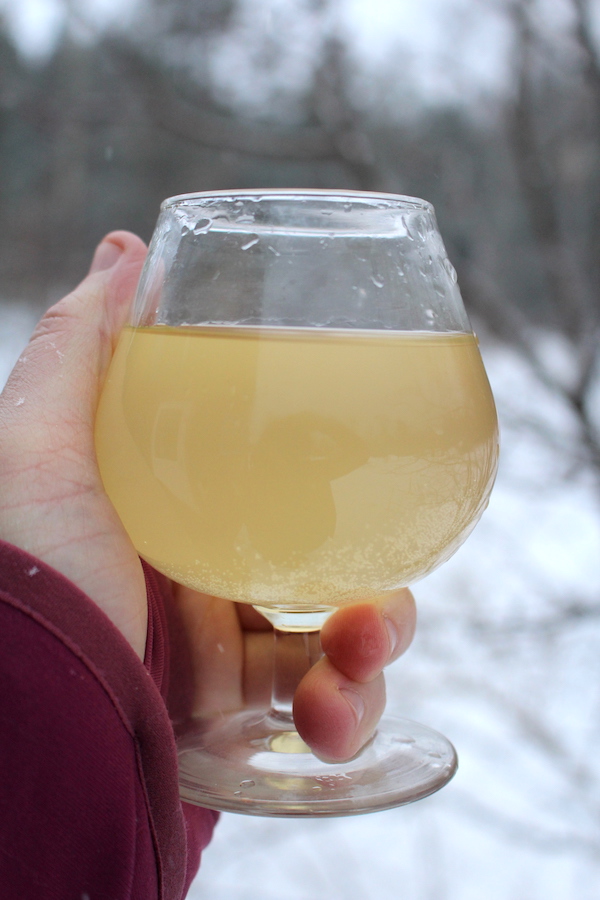
Winemaking Recipes
Looking for more ways to fill your glass with homemade wine?
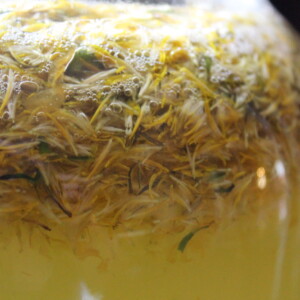
Dandelion Wine
Equipment
Ingredients
- 3 quarts water, approximate, more to fill
- 3 pounds sugar , roughly 5 to 6 cups
- 1- quart dandelion petals, packed from roughly 3-4 quarts blossoms
- 3 medium oranges, juice and zest
- 1 medium lemons, juice and zest
- 1 tsp yeast nutrient
- 1 packet wine yeast
Instructions
- Bring the water and sugar to a boil in a saucepan. Stir to dissolve the sugar and cool to lukewarm.
- Place the dandelion petals, citrus juice and zest into a one-gallon fermentation vessel. Add the yeast nutrient and pour the lukewarm sugar water over the top.
- Dissolve a packet of champagne yeast or other wine yeast in lukewarm water. Allow it to stand for 5 minutes to rehydrate and then pour it into the wine. Top off with a bit of extra water to bring to fill the carboy, but be sure to leave at least an inch of headspace.
- Cap with an airlock and ferment for about 3 weeks or until fermentation has stopped. It will take a bit longer if you don’t use raisins because they provide extra micro-nutrients to get the yeast working faster.
- Siphon the wine into a clean container, leaving the yeast sediment behind. Allow the wine to ferment in secondary for at least 6 to 8 weeks, checking the water lock periodically to ensure that the water hasn’t evaporated.
- Sciphon the dandelion wine into a clean container, again leaving the sediment behind, to prepare for bottling.
- Bottle the dandelion wine in corked wine bottles for longer storage, or flip top Grolsch bottles for tiny batches you’re not planning on storing long.
- Allow the wine age in the bottle at least 2 months before drinking, ideally 6 months or more. Note: During aging, the wine should be kept somewhere cool-ish like a basement or closet on the north side of the house.
Nutrition
Nutrition information is automatically calculated, so should only be used as an approximation.
Small Batch Dandelion Wine
If you’d like to make dandelion wine without investing a lot of time, divide the recipe by 4 to make a super small 1-quart batch. It’s a great solution for those that just want to try it, but don’t want to spend all day plucking apart petals.
All you need is a quart mason jar and a mason jar fermentation kit.
A full packet of champagne yeast will be overkill in a quart batch, so be sure to only use about 1/4 of a packet. Save the rest for another small batch brew, and maybe give small-batch mead a try with any of these mead recipes.
More Dandelion Recipes
Fun Facts…There’s actually a Ray Bradbury novel titled Dandelion Wine, where the drink serves as a metaphor for packing all the joys of summer into a single bottle. How’s this for nostalgia…
“The summer of ’28 was a vintage season for a growing boy. A summer of green apple trees, mowed lawns, and new sneakers. Of half-burnt firecrackers, of gathering dandelions, of Grandma’s belly-busting dinner. It was a summer of sorrows and marvels and gold-fuzzed bees. A magical, timeless summer in the life of a twelve-year-old boy.”
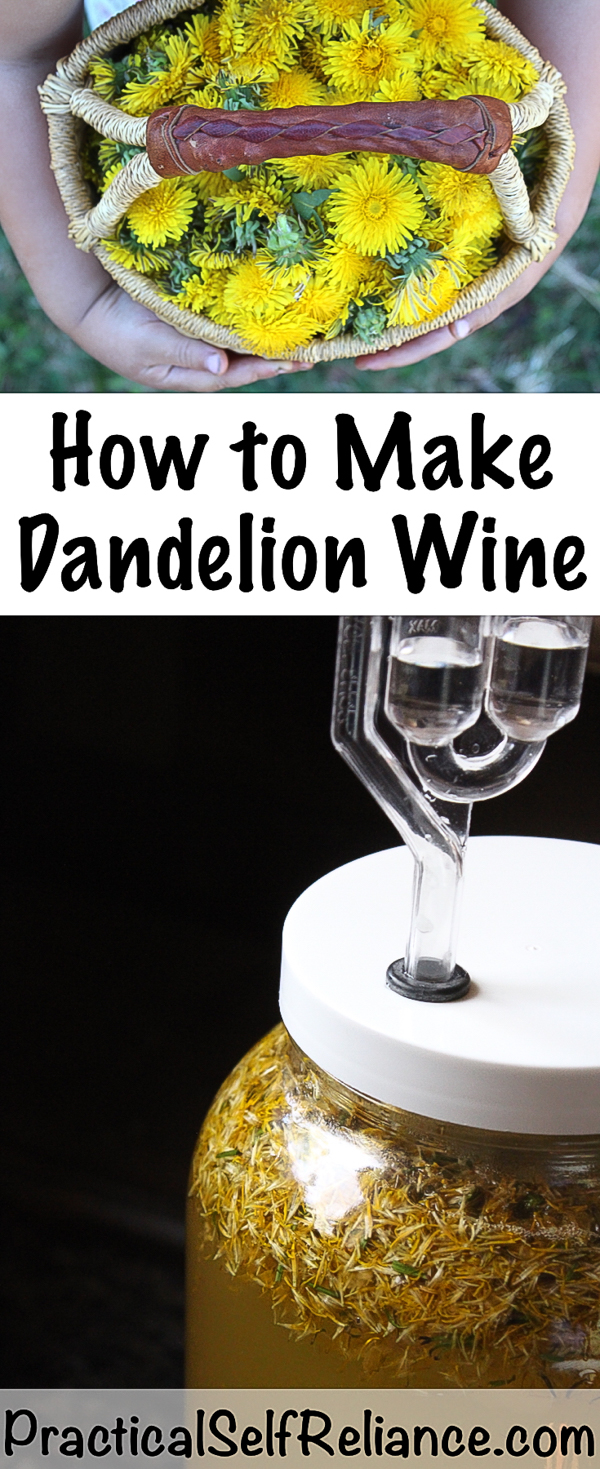


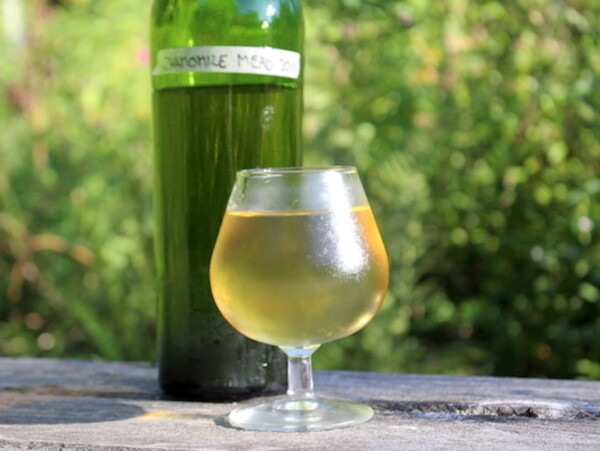
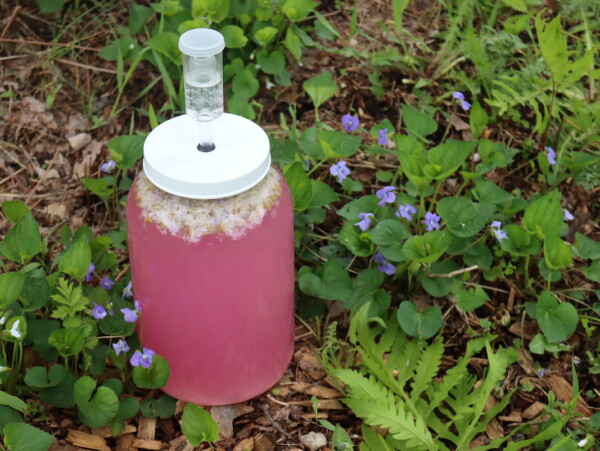
What if the wine is not sweet enough befor bottling?
If you taste it and it’s not sweet enough, you can add simple syrup and rack it again for another week or two before bottling.
Can the initial fermentation be done in a 2 gallon fermentation bucket like other wines?
Of course!
Hi, Ashley! I’ve been using your dandelion wine recipe since 2020, doing 2 gals a year. This year I did the 2 gallons on the same day – one batch, then picking more flowers and doing the second. My wine always seems to be more on the tart side, so I decided to try splitting 1 yeast pack between the 2 batches to see if that made the wine sweeter. It’s been 3 weeks now, and batch 1 has gone clear with sediment on the bottom and fizzy bubbling up from the bottom which I’ve never seen before. Air lock is still perking but slowly. The second batch is cloudy and still perking rapidly. I activated half the yeast packet for the first batch, then activated the rest for the second batch. Yeast was a little past expiration but since fermentation started I figured it was OK. I’m concerned about the fizzing in the first batch – is it ruined? Also, should I let the second batch continue to ferment longer since it’s still perking vigorously? Thanks for you help!
So glad you’ve been enjoying the recipe all these years! If you want to make it a bit sweeter, the way to do that is to either add just a bit more sugar (like 1/4 cup per gallon) or use a yeast with a lower alcohol tolerance. No matter how much yeast you start with they’re going to rapidly multiply in a few days and a pinch or a whole packet will have the same result in the end. The yeast stop fermenting when they reach their alcohol tolerance (percent ABV) and whatever sugar is left at that point will determine how sweet the wine finishes. Choosing a yeast with a 12% alcohol tolerance will yield a sweeter wine than a yeast with a 14% tolerance. If you only have one type of yeast and are happy with how it preforms, you can also add just a tiny bit more sugar. A little goes a long way, so start small. You can always taste it and add a bit more sugar when you rack it into secondary.
For the batch you have going now, your batch sounds like it’s doing just fine, all within the normal range of variation. Assuming you’re totally sure you put the same ingredients in both (ie. one didn’t accidentally get more sugar, etc), sometimes the temperature of the ingredients when they go into the carboy can impact fermentation times like that, and I’d imagine one was cooler than the other at the start. Give the one that’s still actively bubbling more time, it needs to settle down before you rack it into secondary. Otherwise, just keep going, and enjoy!
Thanks so much! I look forward to my dandelions popping up every spring so I can make this wine!
I’m so happy you like it!
Hi Ashley,
Thank you for the recipe. Just have a quick question. After removing the dandelion petals from the liquid for the secondary ferment, there is now 2-3 inches of headspace in the vessel. Is that ok, or should I top it off with a water/sugar mixture?
You can top it off with either more water, or water with a few tablespoons of sugar in it. For more body in the finished wine, you can also top it off with a white grape juice (without preservatives). Really, it’s totally up to you, they all work. The main thing is, you want to try to minimize air contact with the top of your brew if possible, so bringing the ferment up to the neck of the carboy helps with that. It’s not strictly required, and you can leave it as it is and not top it off too.